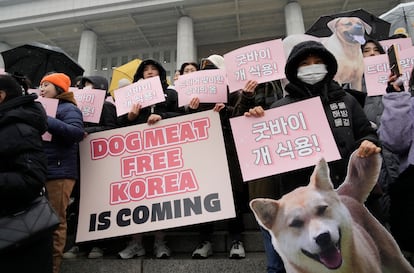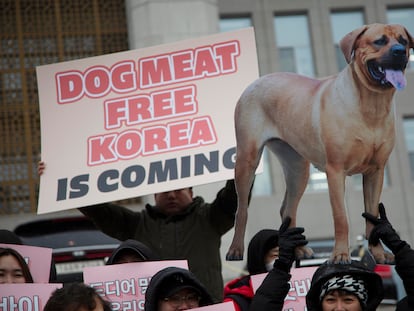How man’s best friend became part of his diet
Thirty million dogs are slaughtered every year for food. Anthropologists believe that the consumption of this animal becomes normalized in times of famine and then, in some cultural contexts, its prohibition gets difficult

In South Korea, saying you love dogs is a bit ambiguous… they can be part of the family, or the menu. However, a bill passed this past week that will finally put an end to this historic custom.
The government has given 1,600 restaurants and 1,150 dog farms in the country three years to present closure or conversion plans. However, this measure won’t put an end to a relatively widespread practice in Asia. Almost 20 countries continue to allow the consumption of dogs. According to Humane Society International (HSI), 30 million puppies and dogs are slaughtered annually for human consumption… although the numbers could be higher, as the sector is highly-unregulated.
Man’s best friend becomes — in certain places and contexts — part of his diet. Anthropologists, historians and biologists are trying to understand why.
From an evolutionary point of view, eating dog meat doesn’t make much sense. This animal was probably the first that humanity domesticated. “We used them for hunting, herding, guarding... and that was much more profitable for us than eating them,” explains Rocío Pérez, an anthropologist who specializes in food at the University of Oviedo (Spain), in a telephone conversation with EL PAÍS.
That utilitarian vision eventually gave way to an interspecies friendship. “Over the centuries, we’ve carried out a process of anthropomorphizing these animals. We’ve begun to see them as members of the family, to the point that eating them almost seems like cannibalism,” Pérez notes. But other societies have evolved differently. It’s a cultural issue. “It may seem strange [in many countries] that they eat dogs, just as it seems strange to [those in certain countries] that we eat other things.”
Korean chef Haesung Yoon and her partner — Raúl Rivelles, of Spain — can attest to this. In 2017, they boasted of making the best paellas in South Korea… without rabbit, of course. “It was impossible to get it and well… I think people would have been shocked if we had included it,” she confesses in a phone interview. “It’s a little strange — you don’t eat rabbit [in South Korea].” Yoon’s perception is quite widespread worldwide. This animal — so present in the Spanish diet — is a gastronomic rarity, an unthinkable taboo in many parts of the world, where rabbits are solely kept as pets.

Over the years, Yoon and Rivelles made the reverse journey. Today, they run a popular Korean food restaurant in Valencia. Dumplings, kimchi, ganjang suyuk... and not for a second did they think about introducing dog meat to the menu. “Its consumption is very [rare],” Rivelles emphasizes. “I didn’t see any restaurant that served it in my four years of living [in South Korea].” Yoon herself has never tried it. “Until my grandfather’s generation, with the war,” she explains, “it was normal to eat dogs, because back then, there was hardly any pork or beef… [those meats] were a luxury. But my parents’ generation stopped doing it. And today, almost nobody does.”
According to a Gallup poll, only 8% of Koreans said they had eaten dogs in 2022, compared to 27% who admitted it in 2015. The consumption of these animals was very popular during the Korean War, from 1950 until 1953. They were used in a dish called bosintang, which could be translated as “soup that’s good for the body.” Curative properties began to be attributed to it and dogs became part of the diet. “Gastronomic customs, over the years, become codified in culture, religion and morality,” Pérez explains. “[A framework] is built to legitimize what’s eaten and what’s not.”
The pigs and the bulls
In history, there are very clear examples of this codification. Muslims and Jews don’t eat pork. And both Islam and Judaism spread through desert areas, where pork wasn’t common anyways, as pigs consume a lot of water and can even be direct competitors with man, as they’re omnivorous. One of the theories is that both religions introduced as dogma what was nothing more than a custom that then spread to other latitudes. This is according to José Miguel Mulet, a professor of Biotechnology and author of the book We Are What We Eat.
“In Spain,” he points out, “they eat so much pork because its public consumption was a means to differentiate themselves from Arabs and Jews.” Thus the slaughter of a pig began to become a social and festive event, in the style of the Muslim festivals in which families share lamb.
But all of this is contextual and historical, evolving with culture. And the evolution — in the Korean case — is more than evident. Over the last 40 years, it has gone from being a low-income country to becoming the 11th-largest economy in the world. Its growth has been accompanied by a cultural explosion: cinema, literature, TV series and music have placed South Korea on the world map. Globalization has made new generations of South Koreans look in the Western mirror… and they haven’t seen anyone eating dogs there. As income has gone up, pet ownership and concern for animal welfare has similarly increased in Korea. The consumption of this meat began to be seen as something strange. But removing a centuries-old custom from a country’s culture isn’t easy.

Successive South Korean governments have tried to ban the consumption of dogs since the 1980s, but they’ve encountered opposition from the most conservative sectors and the Korean Association of Edible Dogs, a group of breeders. They argue that — given its declining popularity among young people — the practice should be allowed to die out naturally, over time. Seeing that their requests haven’t been met, the association has announced that it plans to take the matter to the Constitutional Court. In a BBC report, several breeders declared that it was a war against Korean culture… that there’s a breed of dog that is bred solely for human consumption. They argue that the recently-approved law is “a violation of people’s freedom to eat what they want.”
“In Korea, what’s happening with dogs is what’s happening in Spain with bulls,” Professor Mulet notes. “If you go to a [bullfight], you’ll see that the average age [of attendees] is quite high. So is that of dog consumers. The new generations don’t connect with this. In a globalized world, customs permeate from culture to culture at an increasingly fast pace.”
Expensive and tough meat
In the case of dogs, there are also practical reasons that support abandonment of their consumption. “It’s a disaster from an ecological and economic point of view,” Mulet affirms. “There’s a 10% rule in ecology. Each step of the trophic pyramid only uses 10% of the biomass of the previous one. Each kilo of meat from a carnivore — such as a dog — requires 10 kilos of other herbivorous animals. And these, in turn, require 100 kilos of vegetables.” Furthermore, the biologist points out, dog meat isn’t exactly tasty. “Normally, animals that are raised for human consumption move very little and are slaughtered young, so that the meat is tender and tasty. An animal like a dog — which doesn’t sit still — typically has fibrous and tough meat.”
Hence, Mulet considers that dog consumption is only understood in contexts of need and poverty. In such contexts, the animal that is closest at hand is consumed… even if they’re a pet. “During the post-war period here [in Spain], they ate cats,” he sighs. What seems more strange in South Korea is that this extraordinary consumption is codified in something cultural — that it has crystallized in recipes that are passed down from generation to generation. It has become a trait of national pride among certain older Koreans.
“Imagine if someone had said that eating cats was part of the Spanish identity,” Mulet says. “Well, today, we have certain populations [claiming that] cats are part of gastronomy, when [cat meat] was nothing more than a product consumed out of necessity.” This is what takes place in several cantons in Switzerland, where smoked dog or cat meat is a surviving rarity. According to calculations by the NGO Mensch-Tier-Spirits-Helvetia, around 3% of Swiss people consume these animals from time to time.
In any case, what’s been happening in recent years with dogs isn’t exceptional. “We’ve established that some species can be eaten and others cannot,” explains British journalist Henry Mance — author of the book How to Love Animals (2021) — in an email interview with EL PAÍS. But this list — beyond biological reasons — has cultural implications and is constantly changing. “In some cases, there are animals that are removed from the diet due to their proximity to humans, such as dogs and cats,” Mance points. Others are discarded because they’re considered too dirty, such as rats. Or too majestic and iconic, such as giraffes.
“Nowadays, it’s happening with dogs in Asia. They’ve stopped eating them,” he points out. In addition to South Korea, in recent years, the consumption of dogs has also been prohibited in Hong Kong, India, the Philippines, Singapore, Taiwan and Thailand. And, in countries where it’s still legal, its presence in the diet is increasingly residual.
This process of removing a certain animal from the diet is unstoppable. To understand it, Mace gives the example of what occurred in the late-20th century in Europe and the United States with another animal. “It’s like what happened with the rabbits. Nowadays, they’re too beloved for anyone to want to eat them.”
Sign up for our weekly newsletter to get more English-language news coverage from EL PAÍS USA Edition
Tu suscripción se está usando en otro dispositivo
¿Quieres añadir otro usuario a tu suscripción?
Si continúas leyendo en este dispositivo, no se podrá leer en el otro.
FlechaTu suscripción se está usando en otro dispositivo y solo puedes acceder a EL PAÍS desde un dispositivo a la vez.
Si quieres compartir tu cuenta, cambia tu suscripción a la modalidad Premium, así podrás añadir otro usuario. Cada uno accederá con su propia cuenta de email, lo que os permitirá personalizar vuestra experiencia en EL PAÍS.
¿Tienes una suscripción de empresa? Accede aquí para contratar más cuentas.
En el caso de no saber quién está usando tu cuenta, te recomendamos cambiar tu contraseña aquí.
Si decides continuar compartiendo tu cuenta, este mensaje se mostrará en tu dispositivo y en el de la otra persona que está usando tu cuenta de forma indefinida, afectando a tu experiencia de lectura. Puedes consultar aquí los términos y condiciones de la suscripción digital.
More information
Últimas noticias
Most viewed
- Reinhard Genzel, Nobel laureate in physics: ‘One-minute videos will never give you the truth’
- Oona Chaplin: ‘I told James Cameron that I was living in a treehouse and starting a permaculture project with a friend’
- Pablo Escobar’s hippos: A serious environmental problem, 40 years on
- Why we lost the habit of sleeping in two segments and how that changed our sense of time
- Chevy Chase, the beloved comedian who was a monster off camera: ‘Not everyone hated him, just the people who’ve worked with him’











































